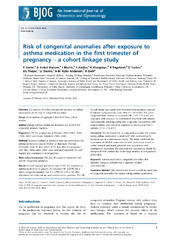| dc.contributor.author | Garne, E | en_US |
| dc.contributor.author | Hansen, A Vinkel | en_US |
| dc.contributor.author | Morris, J | en_US |
| dc.contributor.author | Jordan, S | en_US |
| dc.contributor.author | Klungsøyr, Kari | en_US |
| dc.contributor.author | Engeland, Anders | en_US |
| dc.contributor.author | Tucker, D | en_US |
| dc.contributor.author | Thayer, D S | en_US |
| dc.contributor.author | Davies, G I | en_US |
| dc.contributor.author | Andersen, A-M Nybo | en_US |
| dc.contributor.author | Dolk, H | en_US |
| dc.date.accessioned | 2016-08-08T12:35:21Z | |
| dc.date.available | 2016-08-08T12:35:21Z | |
| dc.date.issued | 2016 | |
| dc.Published | BJOG: an International Journal of Obstetrics and Gynaecology 2016 | eng |
| dc.identifier.issn | 1471-0528 | |
| dc.identifier.uri | https://hdl.handle.net/1956/12493 | |
| dc.description.abstract | Objective: To examine the effect of maternal exposure to asthma medications on the risk of congenital anomalies. Design: Meta-analysis of aggregated data from three cohort studies. Setting: Linkage between healthcare databases and EUROCAT congenital anomaly registries. Population: 519 242 pregnancies in Norway (2004–2010), Wales (2000–2010) and Funen, Denmark (2000–2010). Methods: Exposure defined as having at least one prescription for asthma medications issued (Wales) or dispensed (Norway, Denmark) from 91 days before to 91 days after the pregnancy start date. Odds ratios (ORs) were estimated separately for each register and combined in meta-analyses. Main outcome measures: ORs for all congenital anomalies and specific congenital anomalies. Results: Overall exposure prevalence was 3.76%. For exposure to asthma medication in general, the adjusted OR (adjOR) for a major congenital anomaly was 1.21 (99% CI 1.09–1.34) after adjustment for maternal age and socioeconomic position. The OR of anal atresia was significantly increased in pregnancies exposed to inhaled corticosteroids (3.40; 99% CI 1.15–10.04). For severe congenital heart defects, an increased OR (1.97; 1.12–3.49) was associated with exposure to combination treatment with inhaled corticosteroids and long-acting beta-2-agonists. Associations with renal dysplasia were driven by exposure to short-acting beta-2-agonists (2.37; 1.20–4.67). Conclusion: The increased risk of congenital anomalies for women taking asthma medication is small with little confounding by maternal age or socioeconomic status. The study confirmed the association of inhaled corticosteroids with anal atresia found in earlier research and found potential new associations with combination treatment. The potential new associations should be interpreted with caution due to the large number of comparisons undertaken. | en_US |
| dc.language.iso | eng | eng |
| dc.publisher | Wiley | eng |
| dc.relation.uri | http://onlinelibrary.wiley.com/doi/10.1111/1471-0528.14026/full | |
| dc.rights | Attribution CC BY-NC | eng |
| dc.rights.uri | http://creativecommons.org/licenses/by-nc/4.0/ | eng |
| dc.subject | Asthma medication | eng |
| dc.subject | congenital anomalies | eng |
| dc.subject | first trimester exposure | eng |
| dc.subject | inhaled beta-2 agonists | eng |
| dc.subject | inhaled corticosteroids | eng |
| dc.title | Risk of congenital anomalies after exposure to asthma medication in the first trimester of pregnancy – a cohort linkage study | en_US |
| dc.type | Peer reviewed | |
| dc.type | Journal article | |
| dc.date.updated | 2016-05-18T13:45:49Z | |
| dc.description.version | publishedVersion | en_US |
| dc.rights.holder | Copyright 2016 The Authors | |
| dc.identifier.doi | https://doi.org/10.1111/1471-0528.14026 | |
| dc.identifier.cristin | 1356120 | |

